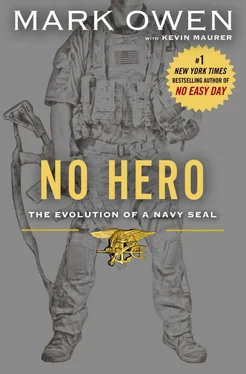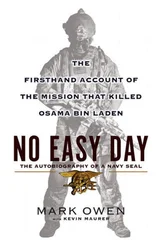I’d arrived in Baghdad a nervous new guy who wasn’t sure I’d click with the Army guys. But I’d learned almost from day one that we had the same mind-set. We shared a common purpose, and that allowed me to become a member of the team. We didn’t get caught up in meaningless rivalry based on the color of our uniform. We may use different equipment and have our own selection courses, but we are all the same in our minds.
We all volunteered to go on the most dangerous missions, where, as Beckwith put it, “a medal, a body bag, or both” are common. We can all accept “low wages, bitter cold, long hours of complete darkness” like Shackleton promised, because we’d all rather die than fail.
But most of all, we always put the team over the individual and never accept anything but the best from everyone. Those words are easy to say and write, but hard to live by. But those are the kinds of men I served with in the special operations community, men who share a common sense of purpose and a nearly identical mind-set.

CHAPTER 6
The Setup
Trust
I stoodin the operations center staring at a massive flat-screen TV. Next to me, Scott scratched at his beard and shook his head.
“Something isn’t right with this,” he said.
Scott was one of the older guys on the team. He’d been around enough to know what “right” looked like.
It had been roughly nine years since those first days of training and my first combat deployment in Iraq. The war had moved to Afghanistan and then back to Iraq and finally back to Afghanistan. I’d been on hundreds of missions and hit all kinds of targets. I’d been doing this long enough to know a good target, and nothing about this target made sense.
The compound on the monitor showing the drone’s feed looked like every other biscuit-colored house in Afghanistan. The walls—made of rocks and mud—were ten to twelve feet high, with a metal gate. The compound sat in the middle of an open field with farmland all around it. A line of trees bordered the field on one side. Several smaller compounds sat less than half a kilometer away.
No children played in the field. We didn’t see any women outside working in the courtyard. No one came in or out of the house. There were no goats or cows around grazing. No men in the nearby fields. The house looked deserted, except that we knew it might contain a high-level al Qaeda commander.
At this point in the war, it was rare to find an al Qaeda commander in Afghanistan. We were mostly tracking and killing little “T” Taliban fighters, who moonlighted between farming and getting their jihad on. The big “T” Taliban leaders were based across the border in Pakistan, where they stayed just out of reach. A legitimate bad guy was smart enough to know better. If an al Qaeda commander was hiding in the house, where was his personal security? No one came to the house to get orders or visit him. Why would an al Qaeda commander come across the border with no security and hang out in a deserted house?
It didn’t add up. Scott was dead-on. This target had to be a trap.
It was a conclusion any of us could draw from our shared experience. For the last several years, special operations forces had been hunting Taliban and al Qaeda commanders and bomb makers. We’d determined their pattern of movement and waited for the perfect opportunity to strike. Once the target location was set, we’d move in and take them out. We had been doing it so long we’d started to think of it as a frustrating campaign of whack-a-mole. Each time we cut the head off of a bomb cell, another leader popped up. We weren’t stopping the insurgency; we were just killing it off in parts. An insurgency doesn’t have to win. It just has to survive.
I cared only about practical matters—the safety of my team, the number of expected enemy fighters, our route in and out. By this time we had plenty of practice playing the game, and a change in the pattern like this one was a major red flag for us all. The thirty thousand–foot strategy mattered little to me when I was eyeing a target. The strategy stuff was for the admirals and the politicians, not for the men on the ground.
Our theater commander decided we would hit the house. He was an Army Ranger colonel on a three-month rotation, and he saw the chance to kill or capture a high-level al Qaeda commander.
“He wants to check the ‘killed an AQ commander’ box so he can be a general,” Scott joked. “Go get ’em, boys, right?”
At the time, I was upset by the order. Taking down a high-ranking commander with a unit under his command always looked good. But I suspect the Ranger colonel could read the pattern as well as we could, and just wanted to be certain an al Qaeda commander wasn’t there. We were all fighting the same enemy, and he was doing what he thought needed to be done. It’s extremely hard not to get emotional in situations like this, especially when people don’t trust you and the stakes are so high.
As I matured through my career, I learned communication was one of the most important things I could provide to leaders and subordinates alike.
Our troop commander did his best to explain our issues with the mission to the Army colonel, but it didn’t work. The troop commander was our highest-ranking officer. While the troop commander was important to our unit, he had likely just graduated from the training pipeline. The troop chief, on the other hand, had been with the command longer than the officer had even been in the Navy. The troop chief was the senior enlisted SEAL in the troop. He was pretty much the Mafia don, or the big cheese. Because experience is what matters most, it was the senior enlisted guys who ran the command.
Both the troop commander and the troop chief told the Ranger colonel we’d seen a few similar houses on previous deployments. The houses were rigged to explode when we arrived.
Because we shared Afghanistan with the Rangers, the commander in charge of the theater rotated every three months between a SEAL and a Ranger officer. It wasn’t the perfect solution because culturally, SEALs and Rangers were on opposite ends of the spectrum, and so one side or the other was always trying to adapt to a commanding officer with a much different style than the troops were used to. We all had the same objectives, but the way we go about our business is vastly different.
The Army has certain institutional ways of doing things, just like the Navy. The difference can be boiled down pretty easily: Rangers think and plan from the top down. The SEALs think and plan from the bottom up.
Typically when we plan an assault, the enlisted team leaders and troop chiefs take the lead. We are trained to be free thinkers, not robots. The Rangers were very much the opposite. The Ranger commander would say, “I want to hit that target tonight,” while a SEAL commander might say, “OK, guys, what do you think? Is this a target worth hitting tonight?”
Every guy in my squadron had been in the SEAL community a minimum of five years. Our guys were older and much more experienced, and we’d built trust both up and down our chain of command through years of combat.
Of course, the Rangers were also deploying and growing their combat experience, but they were typically much younger. Most of the Rangers were twenty years old or younger, compared to the average age of about thirty-one years old for the SEAL team.
The biggest difference was trust, and it hadn’t been established at this point.
My team considered the target and its mysterious stationary cell phone signal, and it didn’t add up. Our instinct was to continue to monitor the target before conducting a raid. There wasn’t any significant movement on the target at all. But nothing we said resonated with the Ranger colonel. It seemed like he didn’t trust us to make the call, even though we felt like we’d earned it. The order came down from the colonel to launch and conduct the raid.
Читать дальше











